Blues music is full of legendary riffs and lyrics that tell stories about anything from people falling on hard times, injustice, to hard-loving women and hard-drinking men. But, the best thing about the blues is that it’s so diverse, which means you can sing about anything, as long as it’s coming from the soul.
The sheer number of different blues styles attests to that, which is why we have early Delta blues, Chicago blues, Texas blues, as well as the blues that was popularized in the UK at the end of the ‘60s by players like Eric Clapton, Jeff Beck, and Rory Gallagher.
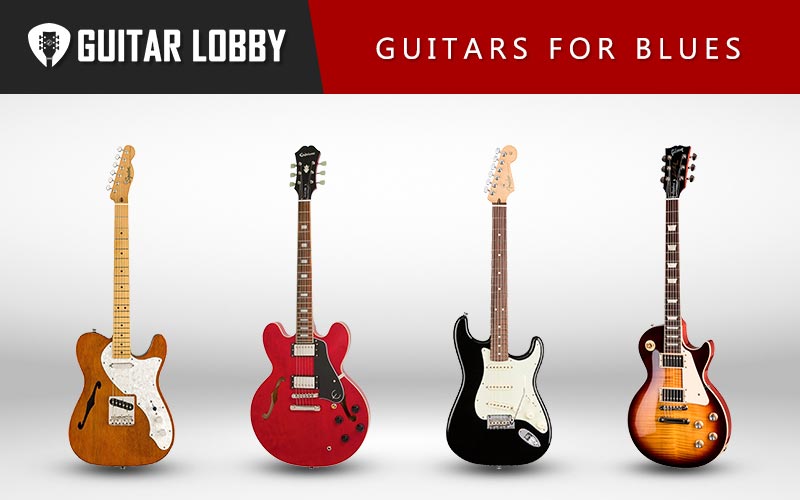
Furthermore, it has spawned and influenced numerous other musical genres, such as rock n roll and hard rock, and to some extent, even metal. All of these different blues facets make your job very difficult when it comes to choosing the right guitar for playing the blues.
While true blues players can pretty much play blues with any kind of guitar, some instruments lend themselves to the genre better than others, as well as those which have left an indelible mark in blues history. We’ll start this article by discussing the best blues guitars at each price point. If you want to learn more about what to look for when buying a blues guitar, we have provided a buying guide at the bottom of the page.
| Name of Product | Image of Product | Description | Price Range | Full Review |
|---|---|---|---|---|
| 1. Fender American Professional Stratocaster Electric Guitar (Best Overall) | 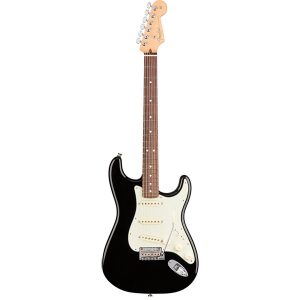 | Body: Solid Ash/Alder Body with Double Cutaway Neck: Maple | $1450 | Read Full Review Below |
| 2. Epiphone Limited Edition ES-335 PRO Electric Guitar (Best Value) | 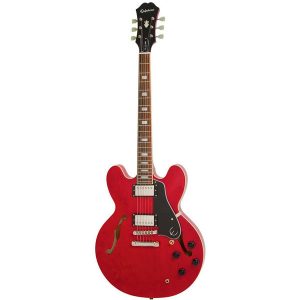 | Body: Semi-Hollow Laminated Maple body with Double Cutaway Neck: Mahogany | $500 | Read Full Review Below |
| 3. Squier Classic Vibe '60s Telecaster Thinline Semi-Hollow Electric Guitar (Budget Pick) | 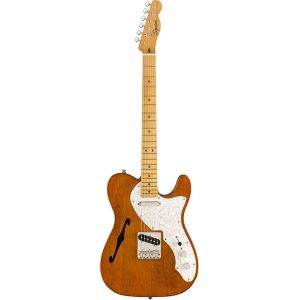 | Body: Semi-Hollow Nato Body with Single Cutaway Neck: Maple | $450 | Read Full Review Below |
| 4. Gibson Les Paul Standard '60s Electric Guitar | 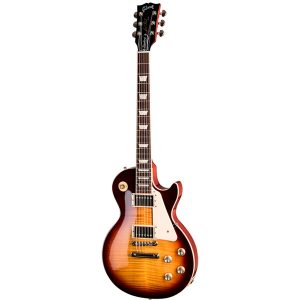 | Body: AA Figured Maple Top on Solid Mahogany Body with Single Cutaway Neck: Mahogany | $2500 | Read Full Review Below |
| 5. PRS Silver Sky John Mayer Signature Electric Guitar | 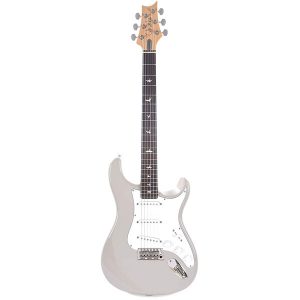 | Body: Solid Alder Body with Double Cutaway Neck: Maple | $2300 | Read Full Review Below |
| 6. Martin 15 Series 000-15M Auditorium Acoustic Guitar | 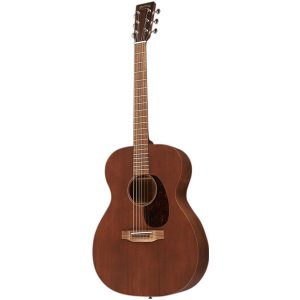 | Body Style: 000-14 Fret Auditorium Top: Solid Genuine Mahogany | $1300 | Read Full Review Below |
| 7. Gretsch Guitars G9200 Boxcar Round-Neck Resonator Guitar | 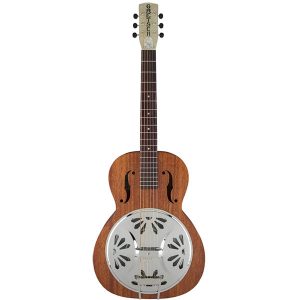 | Body Type: Resonator Neck: Mahogany | $430 | Read Full Review Below |
| 8. Epiphone Les Paul Standard '60s Electric Guitar | 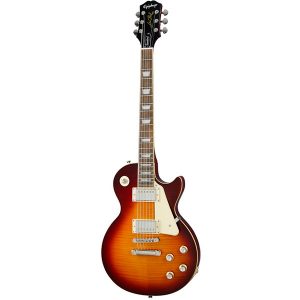 | Body: AA Figured Maple Top on Solid Mahogany Body with Single Cutaway Neck: Mahogany | $600 | Read Full Review Below |
| 9. PRS SE Custom 22 Electric Guitar | 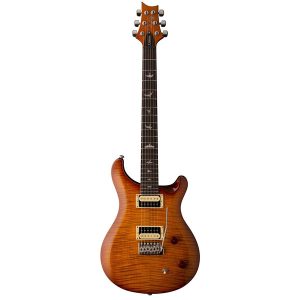 | Body: Maple Top on Solid Mahogany Body with Double Cutaway Neck: Mahogany | $790 | Read Full Review Below |
| 10. Fender American Professional Telecaster Electric Guitar | 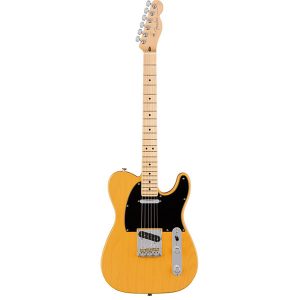 | Body: Sold Ash/Alder Body with Single Cutaway Neck: Maple | $1550 | Read Full Review Below |
| 11. Gibson ES-335 DOT Semi-Hollowbody Electric Guitar | 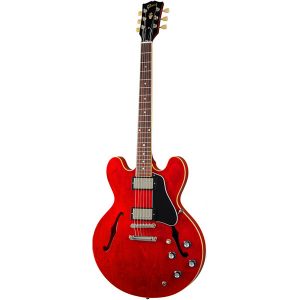 | Body: 3-piece Maple/Poplar/Maple Semi-Hollow Body with Double Cutaway Neck: Mahogany | $3000 | Read Full Review Below |
| 12. Squier Affinity Series Telecaster Electric Guitar | 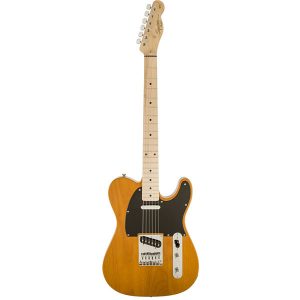 | Body: Solid Alder Body with Single Cutaway Neck: Maple | $230 | Read Full Review Below |
| 13. Godin 5th Avenue CW Kingpin II Archtop Electric Guitar | 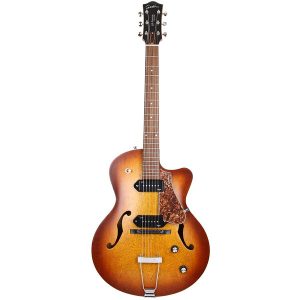 | Body: Canadian Wild Cherry Archtop with Single Cutaway Neck: Silver Leaf Maple | $935 | Read Full Review Below |
| 14. Gretsch Guitars G5655TG Electromatic Center Block Jr. Bigsby Electric Guitar |  | Body: Semi-Hollow Laminated Maple Body with Single Cutaway Neck: Maple | $900 | Read Full Review Below |
Here Are the Best Guitars for Blues Music
1. Fender American Professional Stratocaster Electric Guitar (Best Overall)
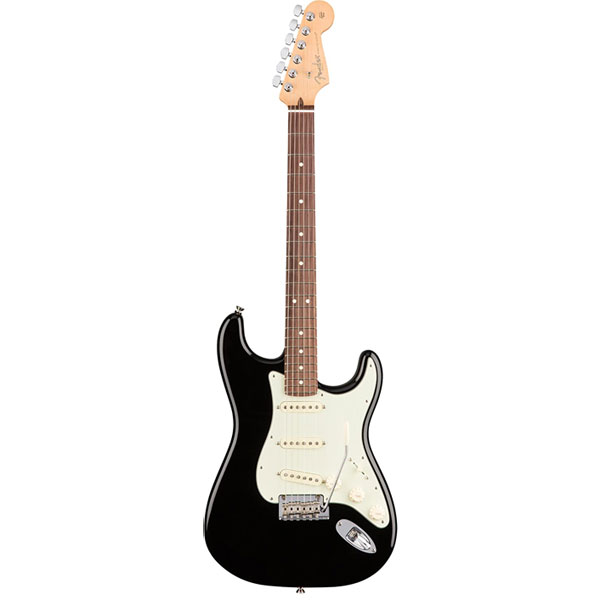
| Estimated Price | $1450 |
| Body | Solid Ash/Alder Body with Double Cutaway |
| Neck | Maple |
| Fretboard | Rosewood |
| Scale Length | 25.5″ |
| Fret Count | 22 |
| Pickups | V-Mod Single-Coil Strat Pickups |
| Bridge | 2-Point Synchronized Tremolo with Bent Steel Saddles and Pop-In Tremolo Arm |
My Review: What is there to say about the iconic Fender Stratocaster? It’s an instrument that has become synonymous with blues and rock, and has been played by legends such as Rory Gallagher, Eric Clapton, Jeff Beck, Jimi Hendrix, Stevie Ray Vaughan, and Eric Johnson, just to name a few. This particular model, the American Professional Stratocaster, is just about the only guitar you will ever need in case you are serious about the blues. All guitars in this series are made in the US, and feature either alder or ash body, depending on the finish, as well as a maple neck with 22 frets.
Three single-coil pickups and the 25.5” scale length give this guitar that characteristic twang, which is perfect for any kind of blues style. The American Professional Stratocaster has a particularly sweet sound when played clean, and it can easily turn into a howling beast with just a little bit of distortion. Whether you like playing smooth, soaring runs like Eric Johnson, or mixing harsh blues-rock attack and delicate picking, like Rory Gallagher, this particular Stratocaster is the one to get if you are a blues player. Not only do you get that signature tone, but you also get superb craftsmanship and versatility.
Who Will Use This Most: Professional recording artists and touring blues musicians alike. While it’s not a cheap guitar by any means, the Fender American Professional Stratocaster is still a bargain, since it’s the kind of instrument you buy and play for a lifetime. Suitable for any genre and blues style.
Bottom Line: The Fender American Professional Stratocaster is a brilliant guitar, and just about the best one you can buy for your money today unless you count the priceless vintage models. Overall, if you’re looking for a guitar for blues music this is an excellent choice.
2. Epiphone Limited Edition ES-335 PRO Electric Guitar (Best Value)

| Estimated Price | $500 |
| Body | Semi-Hollow Laminated Maple body with Double Cutaway |
| Neck | Mahogany |
| Fretboard | Pau Ferro |
| Scale Length | 24.75″ |
| Fret Count | 22 |
| Pickups | Alnico Classic Pro Humbucker Pickups |
| Bridge | Tune-O-Matic Fixed Bridge |
My Review: This is probably the best and most iconic semi-hollow design in the history of the guitar, especially since it’s the very embodiment of blues. We can’t help but think of B.B. King and his Lucille. Of course, if you are looking for the ES-335 made by Gibson, you will have to spend a small fortune. But, if you are still looking for that sort of sound, you will definitely love the more affordable version of the ES-335 made by Epiphone. Before Gibson bought Epiphone, they were known for making some great archtop guitars, and this ES-355 definitely reflects that heritage.
Because this is a semi-hollow electric, you can dial down the distortion and enjoy producing some really bright, woody, and smooth sounds that this particular model is known for. But, when you do decide to turn the dial a bit more, you will get enough grit and dirt that is essential for blues rock. Because this is a budget-friendly model, the body is made out of laminated maple with a mahogany neck. Of course, the Epiphone ES-335 is equipped with two humbucker pickups, which give it that noise-free, warm tone. The guitar, even though it features some of the more affordable materials, is still very well-made. It’s an ES-335, how much more bluesy does a guitar get?
Who Will Use This Most: Beginner blues enthusiasts, because it’s so affordable, as well as those looking to enter the world of semi-hollow guitars on a budget. Also, B.B. King and Chuck Berry fans.
Bottom Line: The Epiphone Limited Edition ES-335 is an amazing electric guitar for the price that looks, feels, and sounds like a true blues guitar should. If you are thinking about buying this one, it’s a no-brainer. For the money, this is easily one of the best blues guitars out there.
3. Squier Classic Vibe 60s Telecaster Thinline Semi-Hollow Electric Guitar (Budget Pick)
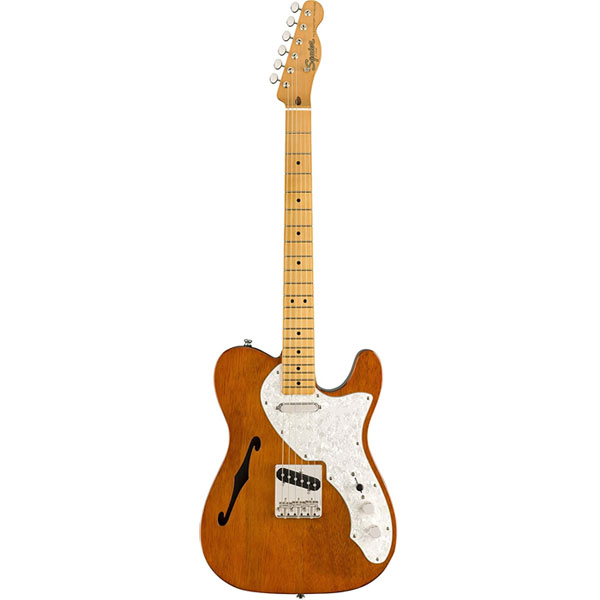
| Estimated Price | $450 |
| Body | Semi-Hollow Nato Body with Single Cutaway |
| Neck | Maple |
| Fretboard | Maple |
| Scale Length | 25.5″ |
| Fret Count | 21 |
| Pickups | Fender Designed Alnico Single-Coil Bridge and Neck Pickups |
| Bridge | 3-Saddle Vintage-Style Strings-Through-Body Tele Bridge with Chrome Barrel Saddles |
My Review: Squier has made quite a few guitars that sound and play great at the same time, but they have really hit it out of the park with the Classic Vibe ‘60 Thinline Semi-Hollow Telecaster. In fact, we are willing to argue that Fender should have promoted this one a lot more. Although you wouldn’t expect to get much for under $500, this electric blues guitar sounds and feels a lot more expensive. We love the details, such as the f-hole, and the large pickguard, as well as the vintage-style machine heads. Because it has a semi-hollow body, you get additional resonance on top of the familiar Telecaster twang, which in itself is perfect for playing any kind of blues tune.
The neck is made out of a single piece of maple, with a maple fingerboard and black dot inlays, and when you combine that with a white pickguard and natural finish, you get a guitar that is not bad-looking either. This Tele comes with Fender-designed Alnico single-coil pickups, one volume and one tone knob, as well as a three-way pickup selector, which enables you to dial in your ideal tone. But, all the superficial things aside, this semi-hollow Telecaster has a very resonant, gritty sound that you wouldn’t get with a normal Tele, which makes it an even better blues guitar. It’s hard to find an electric guitar that will give you more for the price.
Who Will Use This Most: Because of the price, this is an ideal first electric guitar, but viewing it as such would do this instrument a disservice since even seasoned blues players will find much to like about it.
Bottom Line: The Squier ‘60s Thinline Semi-Hollow Telecaster is hands-down the best cheap blues guitar out there. It’s worth a look even if you have a bit more money to spend on a guitar.
Popular Related Article: The Best American Made Guitars on the Market Right Now
4. Gibson Les Paul Standard Electric Guitar
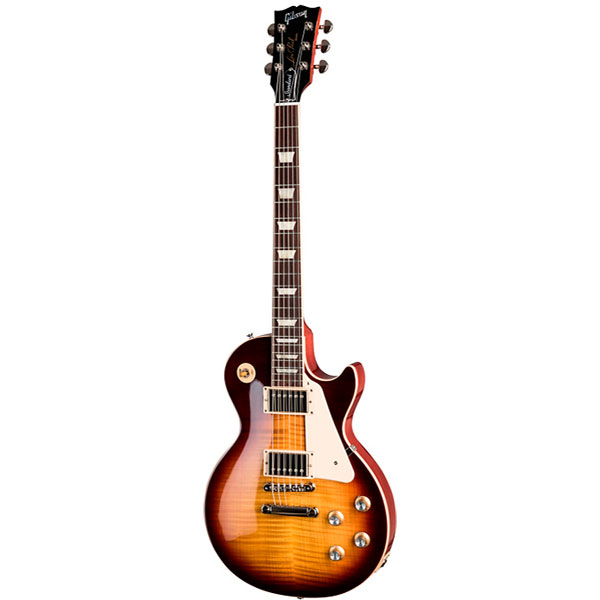
| Estimated Price | $2500 |
| Body | AA Figured Maple Top on Solid Mahogany Body with Single Cutaway |
| Neck | Mahogany |
| Fretboard | Rosewood |
| Scale Length | 24.75″ |
| Fret Count | 22 |
| Pickups | BurstBucker 61R Neck Pickup and BurstBucker 61T Bridge Pickup |
| Bridge | ABR-1 Fixed Bridge |
My Review: No list of blues guitars would be complete without the Gibson Les Paul. Although it’s normally associated with hard rock and other heavier genres, the Les Paul was actually instrumental (no pun intended) in the development of the British Blues scene. Players like Peter Green, Jimmy Page, and Eric Clapton, in his early days, used a Les Paul. Just like it’s archrival, the Stratocaster, the Les Paul Standard ‘60s is an extremely sought-after and versatile instrument. Its warm, deep tone is suitable for clean runs, as well as high-gain solos with lots of bending that has been pioneered and perfected by the likes of Gary Moore and Joe Bonamassa.
The Les Paul Standard ‘60s features two humbucking pickups, one for the bridge and one for the neck, which provide a ton of sustain, so you can easily play screaming solos. One of the things that will discourage a lot of players is the price tag. Yes, this is a pretty expensive guitar, but keep in mind that all Gibson Les Paul guitars are produced in the US, where the level of craftsmanship, quality control, as well as the quality of the materials used to build the guitar is superb. If you are looking for a cheaper alternative, you should look into the Les Paul Studio, or an equivalent Epiphone Les Paul.
Who Will Use This Most: Because of the price tag, this is aimed at professional musicians, as well as those with deeper pockets which are willing to pay more for a premium blues guitar suitable for high-gain playing.
Bottom Line: The Les Paul Standard ‘60s electric guitar is easily among the best blues guitars you can buy for your money today. Everything is there, from the iconic looks to the instantly recognizable sound. We absolutely love it.
5. PRS Silver Sky John Mayer Signature Electric Guitar
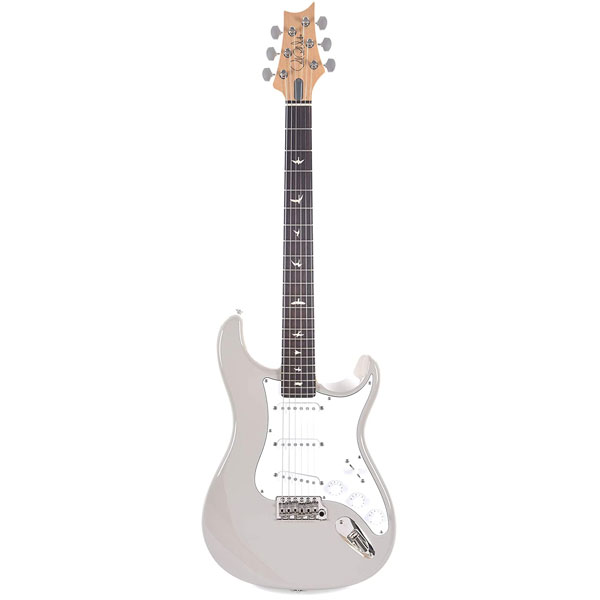
| Estimated Price | $2300 |
| Body | Solid Alder Body with Double Cutaway |
| Neck | Maple |
| Fretboard | Rosewood |
| Scale Length | 25.5″ |
| Fret Count | 22 |
| Pickups | Custom 635JM Single-Coil Artist Signature Pickups |
| Bridge | Tremolo/Vibrato |
My Review: While we are on the subject of premium blues guitars, it’s impossible not to mention PRS guitars. Here, we have the PRS Silver Sky John Mayer Signature model, and at first glance, it looks very familiar, yet there is something odd about it. It looks almost like a Stratocaster, but with a few key differences. First, there is the familiar PRS headstock, as well as the bird inlays on the fretboard. Furthermore, there is the PRS scoop on the bottom cutaway, which allows for better access to upper frets. Then, there are the 635JM single-coil pickups, which represent an improvement upon the standard single-coil pickups, since they have a higher signal-to-noise ratio, whether you are playing clean or with the distortion turned all the way up.
The reason why the PRS Silver Sky looks like a Strat is because John Mayer used to be a Fender Strat player up until 2017 when he switched to PRS. Obviously, he wanted something he was used to, but with a number of key improvements, and Paul Reed Smith was more than happy to oblige. The resulting guitar has the best of both worlds: the famous PRS attention to detail, innovation, and build quality, as well as the best parts from the ‘63 and ‘64 Stratocasters. And because it’s a Strat-style guitar, you get a vintage tremolo bridge. Although it’s definitely strange to see a PRS that looks like a Fender Strat, keep in mind that other guitar manufacturers, such as Ibanez, Yamaha, G&L, as well as Suhr, have been doing the same thing for years now.
Who Will Use This Most: Seasoned professionals who like the vintage Fender sound, but with a few modern twists.
Bottom Line: The PRS Silver Sky is an outstanding guitar that is extremely playable and well-made. It sounds great, and if you can get past the price tag, you will definitely love it.
Popular Related Article: Most Fun Songs to Play on Guitar
6. Martin 15 Series 000-15M Auditorium Acoustic Guitar
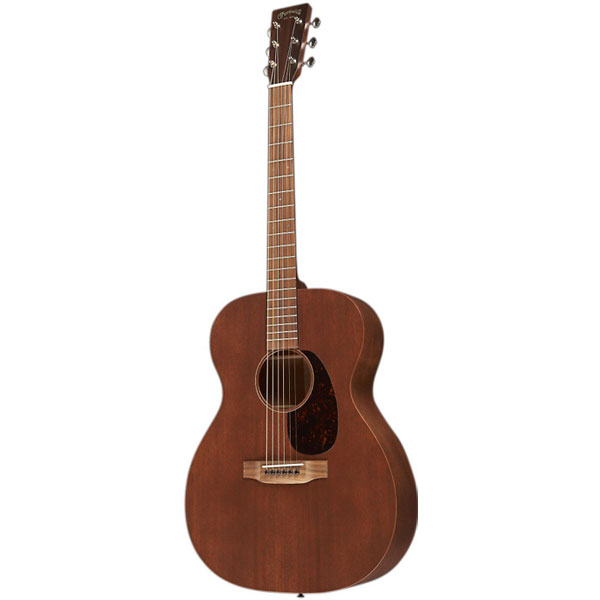
| Estimated Price | $1300 |
| Body | 000-14 Fret Auditorium |
| Neck | Solid Genuine Mahogany |
| Fretboard | Solid Genuine Mahogany |
| Scale Length | Mahogany |
| Fret Count | Satin Nitrocellulose |
| Pickups | X-Bracing |
| Bridge | 20 |
My Review: Since blues can be played on acoustic guitar, as well, we have decided to add one which is absolutely stunning. We are talking about the Martin 000-15M Auditorium acoustic guitar. Martin is known for its high-end acoustics, and the 000-15M embodies all of those qualities. As soon as you look at it, you will notice that the Martin 000-15M is all mahogany, and once you strum it, you will also hear that it’s all solid mahogany. Mahogany has a very warm, rich sound that is somewhat deeper than the sound you would get with other acoustics, which usually have a top made out of Sitka spruce. These tonal qualities make this guitar ideal for blues players.
We love the stripped-down look of the guitar, with a small black pickguard and no binding. Even though there are no usual Martin decorative elements, the 000-15M is one of the best-made guitars out there, and it’s built right here in the US, which explains the price tag. However, you should keep in mind that the guitar comes in a hardshell case as standard. If you love to play Delta blues, this guitar is great, since its sound has enough treble, but it’s the bass-heavy sound that sets this guitar apart from most acoustics.
Who Will Use This Most: Professional acoustic blues players and enthusiasts, as well as anyone who enjoys a great-sounding and expertly crafted acoustic guitar.
Bottom Line: The Martin 000-15M is one of the best acoustic guitars for playing acoustic blues, and if you are aiming for that sort of style, then you should definitely check this one out by all means.
7. Gretsch Guitars G9200 Boxcar Round-Neck Resonator Guitar
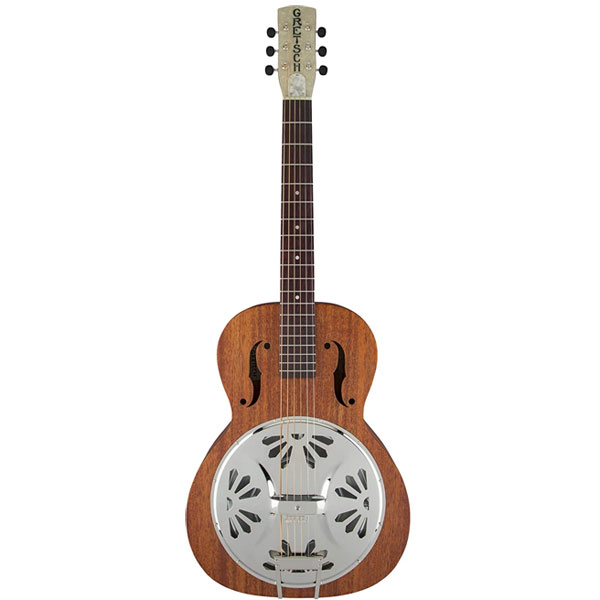
| Estimated Price | $430 |
| Body | $430 |
| Neck | Mahogany |
| Fretboard | Paduak |
| Scale Length | 25” |
| Fret Count | 19 |
| Pickups | Internal Sound Well |
| Bridge | Gretsch Ampli-Sonic Spider, Spun Aluminum |
My Review: if you are a true blues fan, then you definitely have to have a resonator guitar in your arsenal of instruments. We recommend that you check out the Gretsch G9200 Boxcar resonator guitar. Gretsch is known for their quality solid, semi-hollow, and hollow-body guitars, but they also make resonators. The G9200 Boxcar features a mahogany neck with a 25” scale length fretboard made out of rosewood. Note that this is a round-neck resonator, which means you will be able to fret normally, as well as use a slide. Mahogany itself has a deep, rich sound which is even more amplified by the Ampli-Sonic Spider cone construction.
The resonance of the body is even more impressive considering the compact size of this particular resonator. It’s not a ¾ guitar, but it is smaller than your standard auditorium-style acoustic. If you are looking to play some raw Delta blues, the Gretsch G9200 is a superb choice, even if the wooden body produces a more mellow sound than the equivalent all-metal resonator guitar. While looks may not necessarily be essential when choosing a guitar, we have to say that this resonator looks incredible in addition to sounding unique. And the best part about the G9200 is that it’s very affordable, without any compromise on the quality.
Who Will Use This Most: Anyone who is looking to try out a resonator guitar, as well as experienced players looking to dive in more deeply into the blues.
Bottom Line: We could say that the Gretsch G9200 is a great instrument for the price, but it would be more accurate to say that it’s a great blues guitar, regardless of the price tag. Out of all the resonators out there, this is the one you should start with.
8. Epiphone Les Paul Standard ’60s Electric Guitar
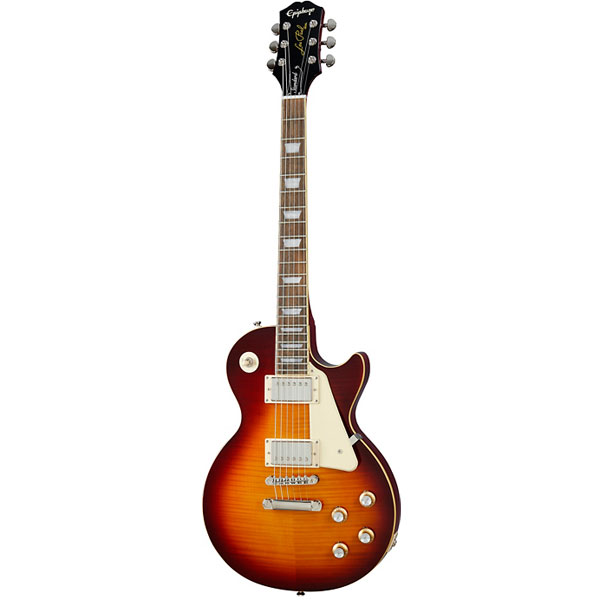
| Estimated Price | $600 |
| Body | AA Figured Maple Top on Solid Mahogany Body with Single Cutaway |
| Neck | Mahogany |
| Fretboard | Indian Laurel |
| Scale Length | 24.75″ |
| Fret Count | 22 |
| Pickups | ProBucker-3 Bridge Pickup and ProBucker-2 Neck Pickup |
| Bridge | LockTone ABR Tune-O-Matic Bridge |
My Review: The Gibson Les Paul is an amazing blues guitar, but it’s very expensive. Enter the Epiphone Les Paul. It’s about the quarter of the price, but it’s about as far from a cheap copy as it can be. Epiphone makes quality instruments, and even though this particular Les Paul is made in China, they have used high-quality materials, and it’s really well-made. The Epiphone Les Paul, just like the original, also has a solid mahogany body with a figured maple top, with a mahogany neck. The only difference is the fretboard, which is not rosewood, but Indian laurel. The headstock sports Grover machine heads, which can also be found on the Gibson Les Paul. So far, so good.
On the body of the Epiphone, you will also find the Tune-O-Matic bridge, as well as two humbucker pickups which are responsible for making all the glorious Les Paul noise. They enable the guitar to fit any kind of blues style, which means you can easily transition from smooth and clean, almost jazzy sound, to thunderous high-gain screaming with a ton of sustain, as you would expect from a Les Paul. Sure, the Gibson Les Paul is a better instrument, but the Epiphone version isn’t too far off. Most of the stuff you get on the original is present here, and that’s more than enough to make this a really great blues guitar.
Who Will Use This Most: Those who prefer a Les Paul, but don’t want to spend over two grand on a Gibson Les Paul. Great for touring musicians, as well.
Bottom Line: The Epiphone Les Paul Standard ‘60s guitar is a great blues guitar in its own right. It sounds incredible, and given its price tag, it’s an absolute steal.
9. PRS SE Custom 22 Electric Guitar
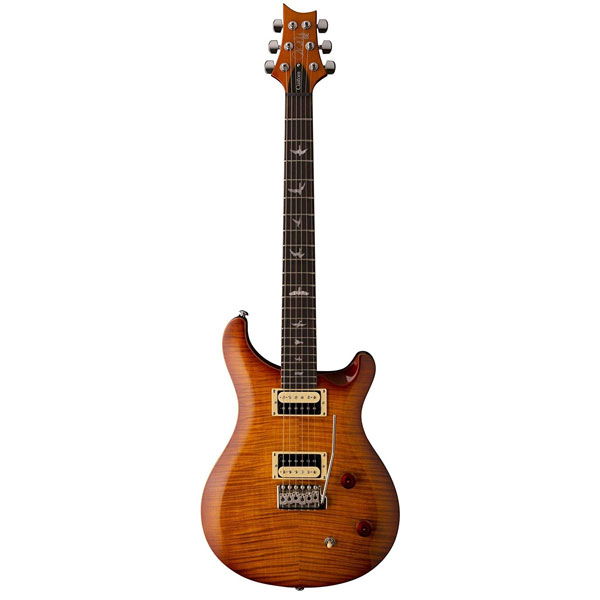
| Estimated Price | $790 |
| Body | Maple Top on Solid Mahogany Body with Double Cutaway |
| Neck | Mahogany |
| Fretboard | Rosewood |
| Scale Length | 25” |
| Fret Count | 22 |
| Pickups | 85/15 “S” Humbucking Pickups with 3-Way Switch and Push/Pull Tone Knob for Coil Tapping |
| Bridge | PRS Patented Tremolo |
My Review: PRS makes some of the finest guitars in existence, and truth be told, it’s better than Fender and Gibson in terms of quality and attention to detail. They weren’t fully appreciated for the longest time, but after they have managed to win over some of the big names, such as Carlos Santana, Mark Tremonti, and more recently, John Mayer, it’s nice to see them get the recognition that they deserve. We are looking at the PRS SE Custom 22 electric guitar. Note that this is an SE model, which means that it’s built-in Indonesia. However, the level of quality for a guitar that is built overseas is just stunning.
You still get a solid mahogany body with a striking maple top, the mahogany neck, and rosewood fretboard. But, there are other PRS elements here, too, such as the beveled top, which makes this guitar even more eye-catching, as well as the double cutaway for easier access to upper frets from both sides. The SE Custom 22 is fitted with two PRS 85/15 S humbucker pickups, one at the bridge and one at the neck, which produce a really sweet, warm clean tone, as well as the intense screaming solos once you crank up the gain or the distortion. This model also has a wide, thin neck, which may put off some players, but once you get used to it, it’s a really fast and comfortable neck.
Who Will Use This Most: Those who love PRS and Les Paul-style guitars, as well as those who are looking for a high-quality instrument well under $1000.
Bottom Line: The PRS Custom 22 is an impressive blues guitar by all accounts, and it’s difficult to think of a better instrument at that price bracket. Highly recommended.
10. Fender American Professional Telecaster Electric Guitar
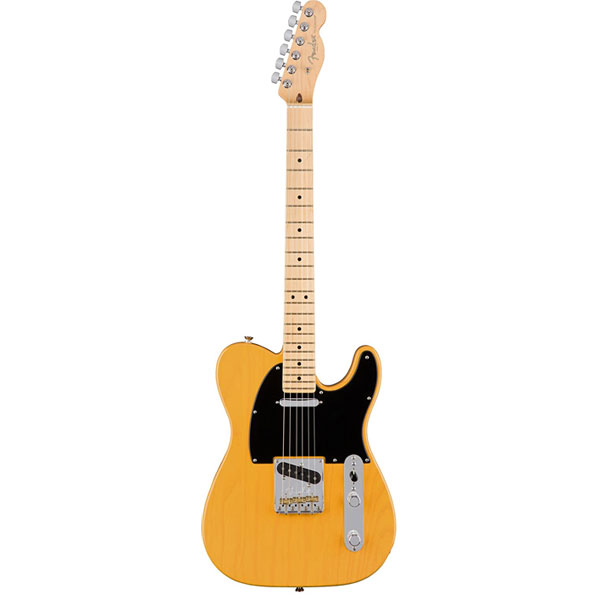
| Estimated Price | $1550 |
| Body | Sold Ash/Alder Body with Single Cutaway |
| Neck | Maple |
| Fretboard | Maple |
| Scale Length | 25.5” |
| Fret Count | 22 |
| Pickups | Tim Shaw Designed V-Mod Pickups with Treble Bleed Circuit |
| Bridge | 3-Saddle String-Through Bridge with Compensated Brass Saddles and Ashtray Cover |
My Review: Our list of blues guitars would not be complete without an American-mad Fender Telecaster. On this occasion, we have selected the Fender American Professional Telecaster, which is everything you would in a Tele. And yes, it has that signature twangy sound in spades. As you would expect from a Telecaster it has a solid ash/alder body, which depends on the kind of finish it comes with, single-coil pickups, as well as a 3-saddle bridge with compensated brass saddles, which is a nice return to tradition. We also love the retro ashtray cover.
As for the sound, this blues guitar manages to pull out the “greatest Tele hits”, since all the characteristic sonic qualities of the Telecaster have been pushed to the max. You get the incredible resonance that rings brightly, but when you do decide to crank things up a bit, this Telecaster responds with plenty of depth and bite. The neck on this one feels slightly thicker, but it’s very comfortable. If nothing but the American-made Telecaster will suffice, then this is the perfect guitar for you.
Who Will Use This Most: Players who love Telecaster, as well as those which prefer a more vintage feel and sound from their blues guitar.
Bottom Line: The Fender American Professional Telecaster sums up everything that’s great about the legendary Telecaster. It’s not cheap by any means, but it’s still miles more affordable than some of the other American-made blues guitars, which makes it such an interesting option.
11. Gibson ES-335 DOT Semi-Hollowbody Electric Guitar
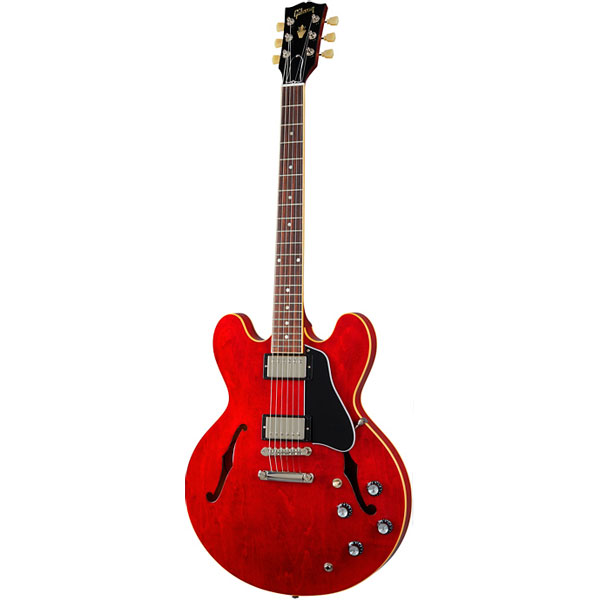
| Estimated Price | $3000 |
| Body | 3-piece Maple/Poplar/Maple Semi-Hollow Body with Double Cutaway |
| Neck | Mahogany |
| Fretboard | Rosewood |
| Scale Length | 24.75″ |
| Fret Count | 22 |
| Pickups | Proprietary Humbuckers |
| Bridge | Fixed |
My Review: We have already reviewed the Epiphone ES-335, but we had to add the original Gibson ES-335 DOT to our list since it is easily the most recognizable and desirable semi-hollow blues guitar of them. It is the very epitome of the blues, and let us spare you the suspense: it’s absolutely mind-blowing. But, the sound and quality are not the mind-blowing things about the Es-335 DOT, since it costs three grand, which is enough to make your jaw drop.
Its semi-hollow body features two proprietary humbucker pickups that enable you to play anything from smooth, clean notes to chords and solos which have a ton of grit in them. The semi-hollow body provides ample sustain, while the wooden block that runs down the center of the guitar makes sure to keep the feedback at bay, which is common on hollow-body guitars. It’s one of the best guitars Gibson has in its line up, and it’s by far the most iconic blues guitar of them all.
Who Will Use This Most: Those with really deep pockets, as well as professional recording artists and season studio musicians.
Bottom Line: The Gibson ES-335 DOT is absolute perfection when it comes to blues guitar and is certainly a contender for the best guitar for blues award. If you can afford it, go out and get it right now. If not, there is still the Epiphone ES-335.
12. Squier Affinity Series Telecaster Electric Guitar
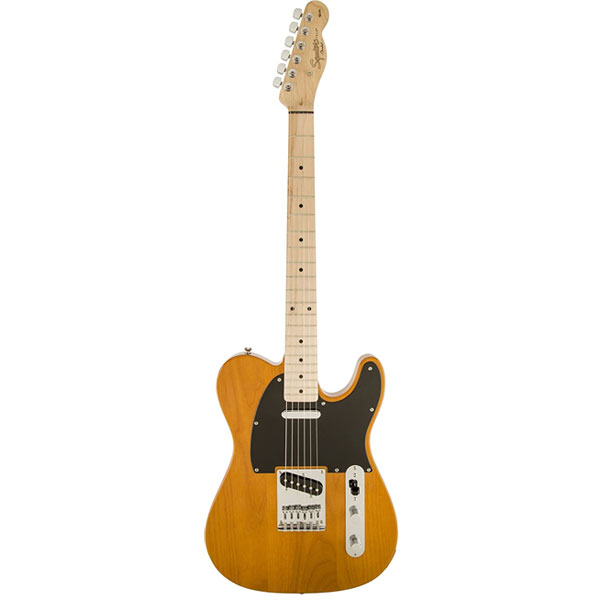
| Estimated Price | $230 |
| Body | Solid Alder Body with Single Cutaway |
| Neck | Maple |
| Fretboard | Maple |
| Scale Length | 25.5” |
| Fret Count | 21 |
| Pickups | Single-Coil Pickups |
| Bridge | 6-Saddle Hardtail with Cast Saddles |
My Review: You would be forgiven for discounting even acoustic guitars which cost a little over $200, since most of them are poorly made and don’t sound very good. That is why this guitar from Squire’s Affinity Series has us so puzzled. We have no idea how Squier was able to build a Telecaster guitar that costs this little, yet is still a good instrument. What’s even more impressive is that this Tele has a solid alder body, which is unheard of in this price range. You also get a maple neck and fretboard. Of course, they have cut corners elsewhere, and it’s built overseas, but it’s still very playable and solid all the way.
You get two single-coil pickups that provide that familiar bright twang we have come to expect from a Telecaster, and which fits so well for blues rock or just straight-up blues. You get volume and tone knobs, as well as pickup selector, and that’s pretty much all you need to set up the sound that you want. Don’t let the price tag fool you, because this is a good guitar. You won’t find anything else this cheap that sounds this good, we promise you.
Who Will Use This Most: This is a great beginner blues guitar, as well as a great beginner guitar, period. It is the very definition of a bargain.
Bottom Line: The Squier Affinity Telecaster is a good cheap guitar, and the only real choice if you are on a tight budget.
13. Godin 5th Avenue CW Kingpin II Archtop Electric Guitar
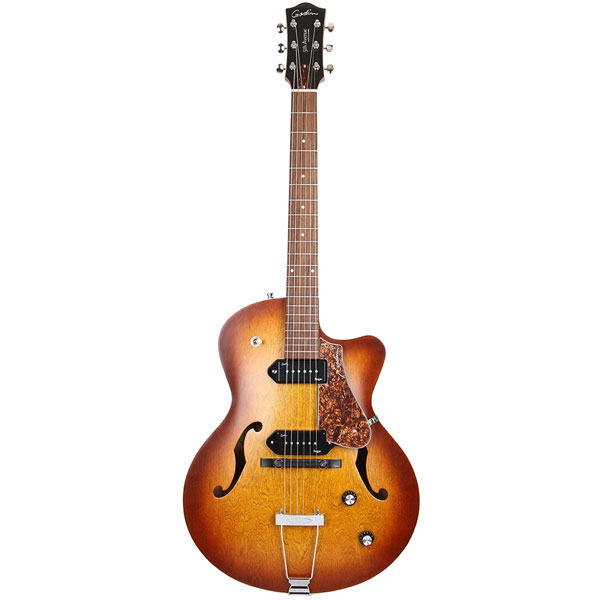
| Estimated Price | $935 |
| Body | Canadian Wild Cherry Archtop with Single Cutaway |
| Neck | Silver Leaf Maple |
| Fretboard | Rosewood |
| Scale Length | 24.84″ |
| Fret Count | 21 |
| Pickups | 2x Godin Kingpin P90 Pickups |
| Bridge | Adjustable Tusq Bridge by Graphtech |
My Review: The Godin 5th Avenue CW Kingpin is an archtop/hollow body guitar that is ideal for playing both jazz and blues. It also sports two Godin Kingpin P90 pickups, which give this guitar an even bluesier sound and appearance. As you would expect from Godin, this guitar is really well-made, and they have used quality materials pretty much everywhere. You get the Canadian wild cherry body, maple neck, and rosewood fretboard. It just looks wonderful, and although it costs a little over $900, it’s a great value because of the quality and craftsmanship.
In fact, we are struggling to think of another archtop guitar that would be able to rival in terms of value and quality. The two P90 pickups enable it to sound very versatile, which means it’s equally at home playing clean notes, as well as bluesy solos with moderate distortion. And best of all, since it’s a hollow-body guitar, you can even play it unplugged.
Who Will Use This Most: Anyone who loves the rich, clear sound or archtop guitars.
Bottom Line: The Godin 5th Avenue CW Kingpin is a high-quality blues guitar by all accounts, and it earns an easy recommendation.
14. Gretsch Guitars G5655TG Electromatic Center Block Jr. Bigsby Electric Guitar
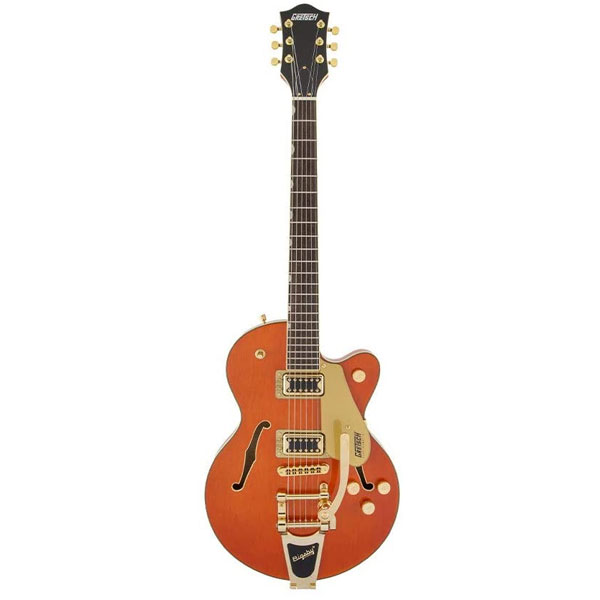
| Estimated Price | $900 |
| Body | Semi-Hollow Laminated Maple Body with Single Cutaway |
| Neck | Maple |
| Fretboard | Laurel |
| Scale Length | 24.6” |
| Fret Count | 22 |
| Pickups | Black Top Broad’Tron |
| Bridge | Adjusto-Matic Tremolo/Vibrato with Bigsby B70 |
My Review: Gretsch makes some of the most beautiful guitars you can currently buy, and the G5655TG is no exception. But, it’s more than just a pretty face, too. Although most people associate Gretsch semi-hollow body guitars with rockabilly, rest assured that it can play some mean blues, especially if you prefer your blues with a good dose of rock thrown in. This is the reason why it has higher output pickups, as opposed to some of the other Gretsch guitars which are a throwback to the ‘50s.
Because it has a center block, the G655TG handles feedback really well, and thanks to the maple body, it resonates really brightly, and you get that additional acoustic tonal quality in your playing, as well. This guitar is equipped with Black Top Broad’tron humbuckers pickups, which make for a really thick, deep sound with plenty of sustain. If you like to play high-gain blues or blues rock, this is the guitar you should be looking at.
Who Will Use This Most: Players who like to cover multiple blues styles. It’s a truly versatile guitar in terms of sound, which means you can play rockabilly, blues, and rock equally well on it.
Bottom Line: The Gretsch G5655TG Electromatic Center Block Jr. Bigsby Electric Guitar is a versatile workhorse of a guitar that also happens to look great. It’s well-made, and it easily justifies its price tag.
Choosing a Guitar for Blues Music (Buying Guide)
As we have mentioned before, technically, there are no guitars that are built strictly for blues or any other genre, but some guitars have certain qualities or traits that make them very suitable for blues, such as particular tonewoods, pickups, or sound. For example, Fender Stratocaster is one of the most popular guitars in the blues world, but it’s not just a blues guitar, since you can play music in pretty much any kind of genre with it. The same goes for Les Paul. There are other popular choices, such as numerous Gretsch Electromatics guitars, as well as the perennial favorite, the Gibson ES-335.
You could take the shorter route and choose a guitar that was played by one of your blues idols, or you can take your time and try out a bunch of guitars until you find exactly what you are looking for. Obviously, that is very timely and challenging, even if you were to limit yourself to solid-body electric guitars. But, what about semi-hollow and hollow-body electrics? Also, you shouldn’t discount acoustic guitars, as well as Resonator-type guitars. That being said, let’s a look at some of the parameters we have mentioned and how much they contribute to the sound of blues guitar.
Acoustic Vs. Electric
Although our guide and our list of guitars are oriented mainly toward electric guitars, you shouldn’t discount acoustic guitars as an option, especially if you like the early Delta blues or if you like to use a slide. Also, players such as Taj Mahal, and to some extent, Rory Gallagher, have shown that blues can sound just as emotional and as exciting when played on acoustic. If you are planning on playing blues within the confines of a band, then you are probably better off with an electric guitar, since it is played through an amp and is able to cut through other loud instruments, such as the drums, as well as vocals.
The acoustic guitar is perfect if you are playing blues by yourself, and if you don’t have to be loud. However, even in this case, there are a couple of considerations. For instance, if you plan on playing live, you should definitely look into getting an acoustic-electric guitar that has a built-in preamp system. In other words, all acoustic-electric guitars have a built-in pickup which allows them to be played through an amp or a PA. You can also use a regular acoustic guitar coupled with a microphone. This does sound better than the preamp option, but it also means that you have to stand or sit steadily in front of the mic the whole time.
Pickups Explained
While tonewoods and body shape and size play a much bigger role in the sound on acoustic guitar, on electric, it’s the pickups that are the stars of the show, so to speak. There are usually three types of pickups that you will come across on electric guitars:
- Single-coil pickups – usually found on Stratocaster and Telecaster-type electric guitars
- Humbucker pickups – most commonly associated with Les Paul-style guitars, as well as SGs and various PRS models
- P90 pickups – these pickups are somewhere in between single-coil and humbucker pickups in terms of sound and size
Single-coil pickups are characterized by their bright, clear, and transparent sound, which lends itself really well to the genre. Although they can be found on many guitars, they are most commonly associated with Stratocasters and Telecasters. One of the reasons why both the Strat and the Tele are so popular in the blues circles is because their single-coil pickups produce an exceptional sound through the amp’s clean channel, as can be heard on tracks like Little Wing by Jimi Hendrix or Lenny by Stevie Ray Vaughan. But, in addition to that, these pickups enable the guitar to sound really smooth and clear regardless of how much overdrive and distortion you use. The downside is that they tend to be pretty noisy.
Humbucker pickups, on the other hand, are noise-free, since they were designed to ‘buck’ the hum, hence their name. Humbucking pickups are better-known for their fatter, muddier sound. They are high-output pickups, which means they can handle any amount of distortion you can throw at them. Of course, they are synonymous with Les Paul-style guitars, although they are also present on pretty much all Gibson guitars, such as the SG, the Flying V, or the Explorer. If you like the fat bluesy tone of Joe Bonamassa or Gary Moore, you should definitely opt for a blues guitar with humbucker pickups.
P90 pickups are less popular than the first two, but they are not a rare sight among blues players, especially those using semi-hollow or hollow-body guitars, but we will get to that later. We’ve mentioned that the P90 pickups are somewhere in between single-coil and humbucker pickups, and that is true, both in terms of dimensions and sound. They have a bright sound that is also thick at the same time, so if you are looking to play leads which sound clear, yet warm, the P90s might be a good option. They also have a great ‘muddy’ sound when paired up with moderate amounts of distortion. However, when you crank up the distortion really high, they tend to sound too thin.
Scale Length Explained
This element is usually overlooked by players when purchasing a blues guitar is the scale length, which can play a huge role when it comes to tuning and the sound of the guitar. Just in case you are not familiar with the measurement, the scale length is the distance between the bridge of the guitar and the guitar’s top nut, which is usually made out of bone, or some kind of plastic or polymer, in case of more affordable guitars. Usually, we can distinguish between two scale lengths: the 25.5” scale, and the 24.75” scale.
The 25.5” scale length is a characteristic of Fender guitars and is one of the reasons for their signature twang produced by their bottom strings. This type of sound is extremely popular and coveted among the blues players. The additional tension created by the longer scale also makes for a guitar that has better tuning stability. On the other hand, Gibson guitars have a 24.75” scale length, which does cause them to go out of tune more easily, but on the plus side, the resulting sound is very deep and warm, and you can easily bend the strings, regardless of the string gauge, which is really important for blues playing. Ultimately, one is not better than the other, and it all comes down to what you prefer.
Guitar Body Styles Explained
We are not talking about the shape of the guitar body itself, but rather the way it is built. Also, this applied exclusively to electric guitars. There are three main electric guitar body styles you can choose from:
- Solid-Body
- Semi-Hollow Body
- Hollow-Body
Solid-body eclectic guitars have a body that is made up of one or more solid pieces of wood. Although you can make an electric guitar out of any kind of wood, or any kind of material for that matter, the most commonly used woods are alder, basswood, ash, and mahogany, whereas electric guitar fretboards are usually made of rosewood or maple. Now, all solid-body guitars produce very little sound when not plugged inside an amp, so a lot of your blues sound is going to depend on the type of pickups that the guitar has, which we have already covered, as well as the amp you are using.
Fender electrics, such as the Strat, Tele, Jaguar, and the Mustang, as well as Gibson electric guitars, such as the Les Paul, SG, Explorer, Firebird, and the Flying V, are all solid-body guitars. This also applies to nearly all PRS guitars, as well as some of the models built by Gretsch and companies that build Superstrat guitars.
Semi-hollow electric guitars, just like the name says, are partially hollow. This means they have a chamber or cavity that is usually split into two parts by a block that runs down the middle of the guitar body and is made out of wood. These guitars have a very distinctive visual look since they have larger bodies than solid-body electric guitars, and which can feature f-holes. These guitars are very responsive, and their sound is as vintage as it gets. They are also very resilient to feedback and have plenty of that sweet sustain you would want in a blues guitar. One of the most iconic semi-hollow body guitars is the Gibson ES-335, which has been popularized by B.B. King. Another company that is famous for its numerous semi-hollow electric guitars is Gretsch.
Hollow-body guitars are also known as archtop guitars since their tops and backs are arched. These guitars are very popular among jazz players, but they are also great for blues players that don’t use a lot of distortion in their playing. Unlike semi-hollow electric guitars, these don’t have a wooden block running down the body of the guitar, which means they are completely hollow. They can also be used without an amp since they have the largest bodies of all electric guitars, and that allows them to resonate. However, they still sound best when plugged into an amp. Keep in mind that these guitars are also very prone to feedback.
Tonewoods
This is somewhat of a controversial subject when it comes to electric guitars. While tonewoods make a world of difference on acoustic guitars, they don’t contribute as much on solid body guitars, since the sound depends mostly on the pickups and the amp. However, there are some subtle nuances between different types of wood that more experienced musicians can pick up on, even in case of electric guitars. In the context of blues guitar, tonewood such as mahogany, which has superb resonance, walnut, alder, ash, and basswood are popular choices for guitar bodies, as well as flamed maple for the top.
Maple is also a common choice for the neck of the guitar, as well as mahogany. On the fretboards, you will usually see some type of rosewood, or even maple, although some budget guitars use laurel as well. In case you are using an acoustic guitar to play blues, it would be a good idea to go with a guitar that has a mahogany body, not just because of the resonance, but also because of its tonal qualities. Most acoustic guitars have spruce tops, because this type of wood resonated extremely well, but the sound it produces might be a bit bright for blues. Mahogany, on the other hand, is nearly as resonant, but has a wonderful warm, darker tone to it which is ideal in a blues context.
Some woods, such as flamed maple or koa, are also used for decorative purposes, because of their unique grain. Some brands, such as PRS, have really taken this approach to a whole new level, and their guitars are some of the most beautiful on the market.
Resonator Guitars
We have also noticed that a lot of blues guitar lists and guides omit the Resonator-style guitars, which is unforgivable, since they were crucial in developing the blues genre, especially among players who prefer to use a slide. Resonator-style guitars were invented out of necessity, since your standard acoustic guitars weren’t loud enough to compete with percussion and brass instruments, and electric guitars weren’t invented yet. Because of their unique construction, resonator guitars are much louder. The earliest models were built out of metal and featured three cone-shaped resonators made out of aluminum.
How do they work? Much like regular acoustic guitars, actually. When you strum the string, the top of the guitar resonates. Here, you also have cones that transfer the vibrations through its perforations, as well as other openings and sound holes in the guitar. Resonator guitars are made using either metal or wood. We can distinguish between two different types of metal resonators bodies: steel, and brass coated with nickel. The former produces a sound that is more raw and sharp, while brass resonators sound more mellow. Wooden resonator guitars, such as Dobro, have a softer impact and an even warmer sound.
When choosing a resonator guitar, you should also take into account its neck profile, since there are those with square or rounded necks. Square-neck resonators have a really high action, which makes them ideal for playing with a metal slide since you wouldn’t be able to rely on standard fretting. They are also good for playing in open tunings. Resonators with rounded necks are more common in the blues circles, and they allow for both standard fretting and slide playing.
Budget:
Of course, with none of us being billionaires, we also have to take into account the price when choosing a blues guitar. When your budget allows you to buy a top-of-the-line blues guitar, the choice is a lot easier, since you know you will be getting a superbly crafted, high-quality instrument. On the other hand, if your budget is more modest, you should still try to get the most bang for your buck, since cheap blues guitars are often difficult to play, with high action, rough neck edges, cheap laminate wood, and subpar tone. Fortunately, there are plenty of guitar manufacturers out there that offer good instruments at reasonable prices.
In case you cannot afford a blues guitar that is built in the US, you can still get a great instrument at a fraction of the cost, since a lot of US companies, such as Fender, Epiphone, and PRS, outsource some of the work to Mexico, Japan, China, and Indonesia. These instruments are very good, and they won’t break the bank. However, keep in mind that one of the reasons why US-made blues guitars have a premium price is because of the craftsmanship and the materials, as well as the strict quality control process.
We hope that our detailed guide on blues guitars will help you make a more informed choice and that you will end up with a blues guitar that will make both you and your audience happy. Good luck!
Wrap Up:
That does it for this article. Let us know what your favorite guitar to play blues music with is in the comments below! Also feel free to drop any comments or questions.

My name is Chris and I’ve had a passion for music and guitars for as long as I can remember. I started this website with some of my friends who are musicians, music teachers, gear heads, and music enthusiasts so we could provide high-quality guitar and music-related content.
I’ve been playing guitar since I was 13 years old and am an avid collector. Amps, pedals, guitars, bass, drums, microphones, studio, and recording gear, I love it all.
I was born and raised in Western Pennsylvania. My background is in Electrical Engineering, earning a Bachelor’s degree from Youngstown State University. With my engineering experience, I’ve developed as a designer of guitar amplifiers and effects. A true passion of mine, I’ve designed, built, and repaired a wide range of guitar amps and electronics. Here at the Guitar Lobby, our aim is to share our passion for Music and gear with the rest of the music community.
